Larimer Square Historic District
Introduction
Text-to-speech Audio
Images
Larimer Square (image from Historic Marker Database)
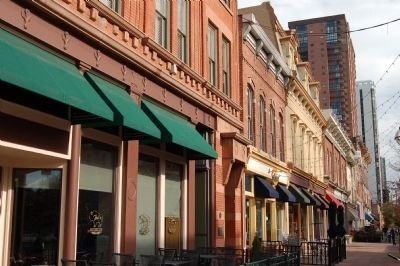
Larimer Street Historic Marker (image from Historic Marker Database)
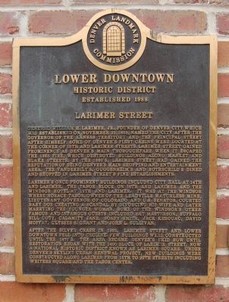
Larimer Street by William Gunnison Chamberlain, 1866 (image from Larimer Square official website)
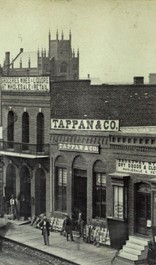
The Clayton Building on Larimer Street, photographed by Kathy Renner, 1973 (image from NRHP)
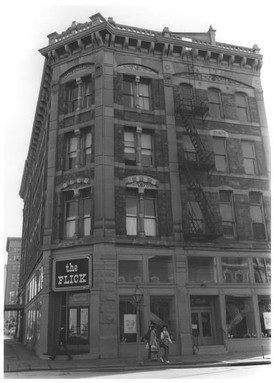
The Crawford Building on Larimer Street, photographed by Kathy Renner, 1973 (image from NRHP)
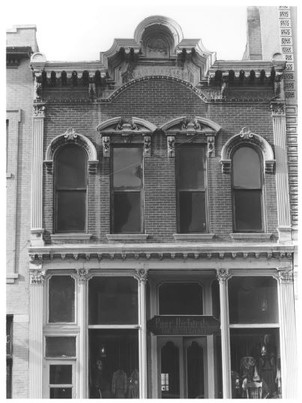
Larimer Square today (image from Larimer Square official website)
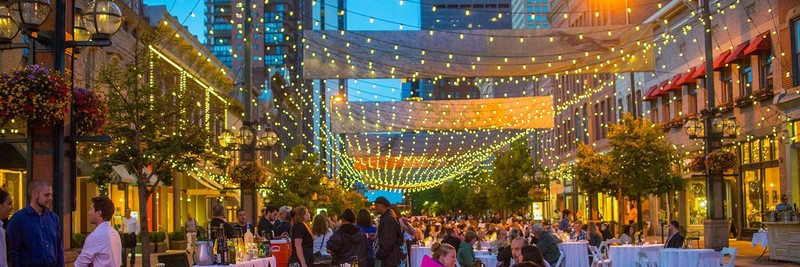
Backstory and Context
Text-to-speech Audio
History of Larimer Square
General William E. Larimer, Jr. founded Denver City on November 22, 1858, only weeks after Green Russell and a group of Georgia settlers established nearby Auraria upon discovering gold. The street which would be named for the General began in Auraria, bridged the Cherry Creek, and continued into the newly established Denver City. Larimer Square, at the intersection of Larimer and F Streets (now 15th Street) consisted of four cabins with doors made from coffins [1; 2]. F Street was part of the military trail connecting Santa Fe, Fort Union, and Arkansas River trading posts, frequented by trappers and frontiersmen including John Smith, Kit Carson, and the Autobees brothers. Only a year later, Denver had grown from a four-structure settlement to a 25-building town, with Larimer Street as its hub and home to Denver's first drugstore, post office, meeting hall, theatre, church, and library. Residents of the Square included William Gilpin, a writer, explorer, and Colorado's first territorial governor; John Evans, Colorado's second governor and founder of Northwestern and Denver Universities; Count Henri Murat, a barber who claimed to be the nephew of Joseph Bonaparte (King of Spain 1806-1808 and Naples 1808-1813); and military man John M. Chivington, who fought at the Battle of Glorieta Pass and the Sand Creek Massacre. A major supply of gold was struck in 1860, prompting the Colorado gold rush and raising Denver's prominence [1]. The same year, in a moonlight ceremony on the Larimer Street Bridge, Auraria was annexed by Denver [2].
From the 1860s to 1880s, Larimer Street became a true Wild West setting, with one saloon for every five buildings, one gambling hall for every ten, a red light district, brawls, and visitors including Calamity Jane, Buffalo Bill Cody, Annie Oakley, Chief Little Raven, Soapy Smith, Richard "Uncle Dick" Wootton, Horace and Baby Doe Tabor, and Molly Brown [1]. A fire at the Cherokee House saloon on April 19, 1863, spread and destroyed 70 buildings in Denver; though Larimer Street's buildings survived, city ordinance required brick or stone construction to replace wooden structures [2]. After a flood the following year, Larimer Square's log cabin structures were replaced according to the new ordinance. Silver mines in Leadville and Central City brought profits to Denver, funding the construction of the Tabor Building and the Windsor Hotel in the early 1880s [1]. The Clayton Building (now called the Granite Building) was constructed by real estate tycoon G.W. Clayton (founder of Clayton College for poor orphans) and William M. Clayton in 1882 on the site of William Larimer's log cabin; the building later became the Granite Hotel [2].
In 1893, the price of silver crashed and the gold standard was adopted. Colorado relied primarily on the silver industry by this time, and Larimer Street growth halted, the buildings soon derelict. By 1900, the street was Denver's Skid Row. Though Larimer Street's Gahan's Soft Drink Parlor was home to the city's most popular speakeasy during Prohibition, the street failed to thrive even after the post-World War II boom, and the city of Denver considered demolition of the historic Square in the 1950s. However, Denver native Dana Crawford formed Larimer Square Associates in 1965 to preserve and refurbish the buildings, revitalize the neighborhood, and restore the structures to their original uses for retail, restaurant, entertainment, and office spaces [1; 2].
Historic Marker Inscription:
Larimer Street
Lower Downtown Historic District
—Established 1988 —
General William H. Larimer, Jr., founder of Denver City which was established on November 22, 1858, named the city after the Governor of the Kansas Territory and the principal street after himself. Some of Denver’s first cabins were located at the corner of 15th and Larimer Streets. Larimer Street gained prominence as Denver’s main thoroughfare when it escaped the 1863 fire, which destroyed buildings along Market and Blake Streets. By the 1880’s, Larimer Street has gained the reputation of being Denver’s main shopping and entertainment area. The Vanderbilt’s, Guggenheim’s and Rothschild’s dined and shopped in Larimer Street’s fine establishments.
Larimer’s once prominent buildings included City Hall at 14th and Larimer, the Tabor Block on 16th and Larimer and the Windsor Hotel at 18th and Larimer. It was at the Windsor where Horace Tabor, owner of the Leadville Matchless Mine, Lieutenant Governor of Colorado and U.S. Senator, courted Baby Doe creating a scandal by divorcing his wife and later marrying the younger women. Some of the Windsor’s other famous and infamous guests included Bat Masterson, Buffalo Bill Cody, Calamity Jane, Soapy Smith, Jack Kerouac, David Moffat, Ulysses S. Grant and John L. Sullivan.
After the silver crash of 1893,
Larimer Street and Lower Downtown fell into decline. Few buildings were
constructed until the 1970’s. The area became Denver’s Skid Row until
restoration began with the 1400 block of Larimer Street, now a National
Historic District known as Larimer Square. Under Denver’s Skyline Urban Renewal
Project, new buildings were constructed along Larimer from 15th to 20th Streets
including Writers Square and the Tabor Center.
Erected by Lower Downtown Historic District [3].
Cite This Entry
Marian, Sara. "Larimer Square Historic District." Clio: Your Guide to History. June 22, 2016. Accessed April 12, 2025. https://theclio.com/tour/44/13/reverse

